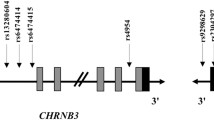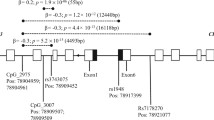Abstract
Based on our previously identified linkage regions for nicotine dependence (ND), we selected six and five single nucleotide polymorphisms (SNPs) in the muscarinic cholinergic receptor subtype M1 (CHRM1) and nicotinic cholinergic receptor β1 (CHRNB1), respectively, to determine the association of the two genes with ND in a total of 2,037 subjects from 602 nuclear families of either African-American (AA) or European-American (EA) origin. Individual SNP- and/or haplotype-based analyses indicated that the CHRNB1 was significantly associated with ND, which was assessed by smoking quantity (SQ), the Heaviness of Smoking Index (HSI), and the Fagerström Test for ND (FTND), in both ethnic samples. The association of rs2302763 in the CHRNB1 was significant with adjusted SQ in the EA sample after correction for multiple testing (P = 0.013). Haplotype A-T-A formed by SNPs rs2302765, rs2302762, and rs9217 in the CHRNB1 was significantly associated with the high risk allele for all the three ND measures (minimum P = 0.009, 0.006, and 0.008 for SQ, HSI and FTND, respectively) in the AA sample while haplotype A-T-A formed by rs2302765, rs2302763, and rs9217 was significantly positively associated with ND (minimum P = 0.005, 0.016, and 0.016 for SQ, HSI and FTND, respectively) in the EA sample. The CHRM1 exhibited significant protective associations of haplotype C-C-A-T-G-G formed by all six SNPs of this gene with at least one ND measure in the AA sample after Bonferroni correction (minimum P = 0.008, 0.013, and 0.009 for SQ, HSI and FTND, respectively), but no significant association was found in the EA sample. The significant associations, together with their location of linked region to ND, suggest that the CHRNB1 and CHRM1 are likely candidates for further investigation.

Similar content being viewed by others
References
Arcos-Burgos M, Castellanos FX, Pineda D, Lopera F, Palacio JD, Palacio LG, Rapoport JL, Berg K, Bailey-Wilson JE, Muenke M (2004) Attention-deficit/hyperactivity disorder in a population isolate: linkage to loci at 4q13.2, 5q33.3, 11q22, and 17p11. Am J Hum Genet 75:998–1014
Barrett JC, Fry B, Maller J, Daly MJ (2005) Haploview: analysis and visualization of LD and haplotype maps. Bioinformatics 21:263–265
Berrettini WH, Lerman CE (2005) Pharmacotherapy and pharmacogenetics of nicotine dependence. Am J Psychiatry 162:1441–1451
Bierut LJ, Rice JP, Goate A, Hinrichs AL, Saccone NL, Foroud T, Edenberg HJ, Cloninger CR, Begleiter H, Conneally PM, Crowe RR, Hesselbrock V, Li TK, Nurnberger JI Jr, Porjesz B, Schuckit MA, Reich T (2004) A genomic scan for habitual smoking in families of alcoholics: common and specific genetic factors in substance dependence. Am J Med Genet 124A:19–27
Clark AG (2004) The role of haplotypes in candidate gene studies. Genet Epidemiol 27:321–333
Duggirala R, Almasy L, Blangero J (1999) Smoking behavior is under the influence of a major quantitative trait locus on human chromosome 5q. Genet Epidemiol 17(Suppl 1):S139–S144
Felder CC, Porter AC, Skillman TL, Zhang L, Bymaster FP, Nathanson NM, Hamilton SE, Gomeza J, Wess J, McKinzie DL (2001) Elucidating the role of muscarinic receptors in psychosis. Life Sci 68:2605–2613
Gabriel SB, Schaffner SF, Nguyen H, Moore JM, Roy J, Blumenstiel B, Higgins J, DeFelice M, Lochner A, Faggart M, Liu-Cordero SN, Rotimi C, Adeyemo A, Cooper R, Ward R, Lander ES, Daly MJ, Altshuler D (2002) The structure of haplotype blocks in the human genome. Science 296:2225–2229
Gotti C, Clementi F (2004) Neuronal nicotinic receptors: from structure to pathology. Prog Neurobiol 74:363–396
Hamilton SE, Hardouin SN, Anagnostaras SG, Murphy GG, Richmond KN, Silva AJ, Feigl EO, Nathanson NM (2001) Alteration of cardiovascular and neuronal function in M1 knockout mice. Life Sci 68:2489–2493
Hamilton SE, Schlador ML, McKinnon LA, Chmelar RS, Nathanson NM (1998) Molecular mechanisms for the regulation of the expression and function of muscarinic acetylcholine receptors. J Physiol Paris 92:275–278
Heatherton TF, Kozlowski LT, Frecker RC, Fagerstrom KO (1991) The Fagerstrom test for nicotine dependence: a revision of the fagerstrom tolerance questionnaire. Br J Addict 86:1119–1127
Henningfield JE, Fant RV (1999) Tobacco use as drug addiction: the scientific foundation. Nicotine Tob Res 1(Suppl 2):S31–S35
Henningfield JE, Jude NR (1999) Prevention of nicotine addiction: neuropsychopharmacological issues. Nicotine Tob Res 1(Suppl 1):S41–S48
Horvath S, Xu X, Lake SL, Silverman EK, Weiss ST, Laird NM (2004) Family-based tests for associating haplotypes with general phenotype data: application to asthma genetics. Genet Epidemiol 26:61–69
http://en.wikipedia.org/wiki/Muscarinic_acetylcholine_receptor Muscarinic acetylcholine receptor. From Wikipedia, the free encyclopedia
Hu D, Cao K, Peterson-Wakeman R, Wang R (2002) Altered profile of gene expression in rat hearts induced by chronic nicotine consumption. Biochem Biophys Res Commun 297:729–736
Karlin A (2002) Emerging structure of the nicotinic acetylcholine receptors. Nat Rev Neurosci 3:102–114
Lange C, Silverman EK, Xu X, Weiss ST, Laird NM (2003) A multivariate family-based association test using generalized estimating equations: FBAT-GEE. Biostatistics 4:195–206
Le Novere N, Corringer PJ, Changeux JP (2002) The diversity of subunit composition in nAChRs: evolutionary origins, physiologic and pharmacologic consequences. J Neurobiol 53:447–456
Levey AI (1993) Immunological localization of m1–m5 muscarinic acetylcholine receptors in peripheral tissues and brain. Life Sci 52:441–448
Levey AI (1996) Muscarinic acetylcholine receptor expression in memory circuits: implications for treatment of Alzheimer disease. Proc Natl Acad Sci USA 93:13541–13546
Li J, Ji L (2005) Adjusting multiple testing in multilocus analyses using the eigenvalues of a correlation matrix. Heredity 95:221–227
Li MD, Beuten J, Ma JZ, Payne TJ, Lou XY, Garcia V, Duenes AS, Crews KM, Elston RC (2005) Ethnic- and gender-specific association of the nicotinic acetylcholine receptor alpha4 subunit gene (CHRNA4) with nicotine dependence. Hum Mol Genet 14:1211–1219
Li MD, Cheng R, Ma JZ, Swan GE (2003a) A meta-analysis of estimated genetic and environmental effects on smoking behavior in male and female adult twins. Addiction 98:23–31
Li MD, Ma JZ, Beuten J (2004) Progress in searching for susceptibility loci and genes for smoking-related behaviour. Clin Genet 66:382–392
Li MD, Ma JZ, Cheng R, Dupont R, Williams KC, Payne TJ, Elston RC (2003b) A genome wide scan to identify loci for smoking quantity in the Framingham Heart Study populations. BMC Genet 4(Suppl 1):S103
Lukas RJ, Ke L, Bencherif M, Eisenhour CM (1996) Regulation by nicotine of its own receptors. Drug Dev Res 38:136–148
Mokdad AH, Marks JS, Stroup DF, Gerberding JL (2004) Actual causes of death in the United States, 2000. JAMA 291:1238–1245
Munafo MR, Shields AE, Berrettini WH, Patterson F, Lerman C (2005) Pharmacogenetics and nicotine addiction treatment. Pharmacogenomics 6:211–223
Neale BM, Sham PC (2004) The future of association studies: gene-based analysis and replication. Am J Hum Genet 75:353–362
Niu T, Chen C, Ni J, Wang B, Fang Z, Shao H, Xu X (2000) Nicotine dependence and its familial aggregation in Chinese. Int J Epidemiol 29:248–252
Nyholt DR (2004) A simple correction for multiple testing for single-nucleotide polymorphisms in linkage disequilibrium with each other. Am J Hum Genet 74:765–769
O’Connell JR, Weeks DE (1998) PedCheck: a program for identification of genotype incompatibilities in linkage analysis. Am J Hum Genet 63:259–266
Picciotto MR, Caldarone BJ, King SL, Zachariou V (2000) Nicotinic receptors in the brain. Links between molecular biology and behavior. Neuropsychopharmacology 22:451–465
Rose JE (1996) Nicotine addiction and treatment. Annu Rev Med 47:493–507
Stallings MC, Corley RP, Dennehey B, Hewitt JK, Krauter KS, Lessem JM, Mikulich-Gilbertson SK, Rhee SH, Smolen A, Young SE, Crowley TJ (2005) A genome-wide search for quantitative trait Loci that influence antisocial drug dependence in adolescence. Arch Gen Psychiatry 62:1042–1051
Straub RE, Sullivan PF, Ma Y, Myakishev MV, Harris-Kerr C, Wormley B, Kadambi B, Sadek H, Silverman MA, Webb BT, Neale MC, Bulik CM, Joyce PR, Kendler KS (1999) Susceptibility genes for nicotine dependence: a genome scan and followup in an independent sample suggest that regions on chromosomes 2, 4, 10, 16, 17 and 18 merit further study. Mol Psychiatry 4:129–144
Su AI, Cooke MP, Ching KA, Hakak Y, Walker JR, Wiltshire T, Orth AP, Vega RG, Sapinoso LM, Moqrich A, Patapoutian A, Hampton GM, Schultz PG, Hogenesch JB (2002) Large-scale analysis of the human and mouse transcriptomes. Proc Natl Acad Sci USA 99:4465–4470
Sullivan PF, Kendler KS (1999) The genetic epidemiology of smoking. Nicotine Tob. Res 1(Suppl 2):S51–S57; discussion S69–S70
Sullivan PF, Neale BM, van den Oord E, Miles MF, Neale MC, Bulik CM, Joyce PR, Straub RE, Kendler KS (2004) Candidate genes for nicotine dependence via linkage, epistasis, and bioinformatics. Am J Med Genet B Neuropsychiatr Genet 126:23–36
Sullivan PF, Neale MC, Silverman MA, Harris-Kerr C, Myakishev MV, Wormley B, Webb BT, Ma Y, Kendler KS, Straub RE (2001) An association study of DRD5 with smoking initiation and progression to nicotine dependence. Am J Med Genet 105:259–265
Swan GE (1999) Implications of genetic epidemiology for the prevention of tobacco use. Nicotine Tob Res 1(Suppl 1):S49–S56
USDHHS (1988) The health consequences of smoking: nicotine addiction. A report of the surgeon general. Department of Health and Human Services, Washington, DC
USDHHS (2000) Reducing tobacco use: a report of the surgeon general. US Department of Health & Human Services, Center for Disease Control and Prevention, National Center for Chronic Disease Prevention and Health Promortion, Atlanta, GA
Wang D, Ma JZ, Li MD (2005) Mapping and verification of susceptibility loci for smoking quantity using permutation linkage analysis. Pharmacogenomics J 5:166–172
Watkins SS, Koob GF, Markou A (2000) Neural mechanisms underlying nicotine addiction: acute positive reinforcement and withdrawal. Nicotine Tob Res 2:19–37
WHO (2002) The World Health Report 2002. World Health Organization
Author information
Authors and Affiliations
Corresponding author
Rights and permissions
About this article
Cite this article
Lou, XY., Ma, J.Z., Payne, T.J. et al. Gene-based analysis suggests association of the nicotinic acetylcholine receptor β1 subunit (CHRNB1) and M1 muscarinic acetylcholine receptor (CHRM1) with vulnerability for nicotine dependence. Hum Genet 120, 381–389 (2006). https://doi.org/10.1007/s00439-006-0229-7
Received:
Accepted:
Published:
Issue Date:
DOI: https://doi.org/10.1007/s00439-006-0229-7




